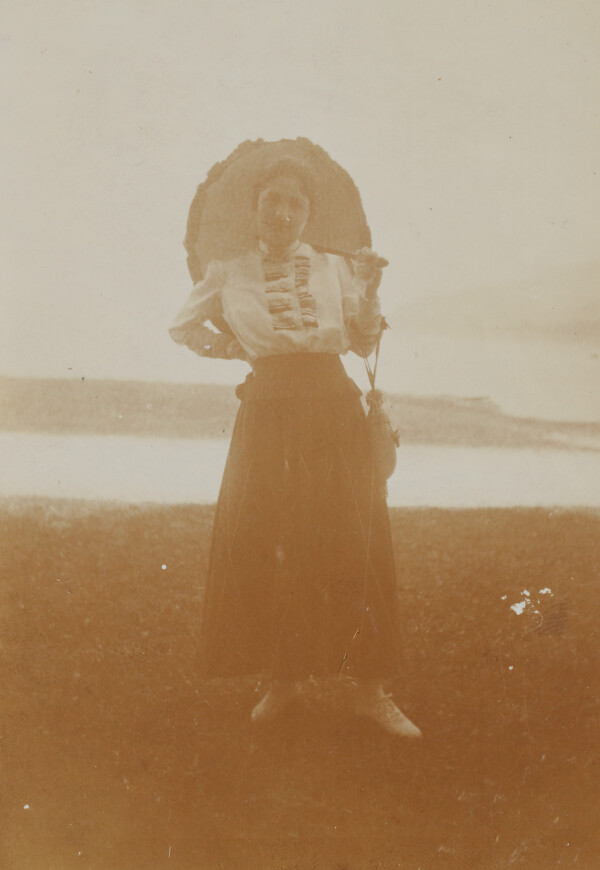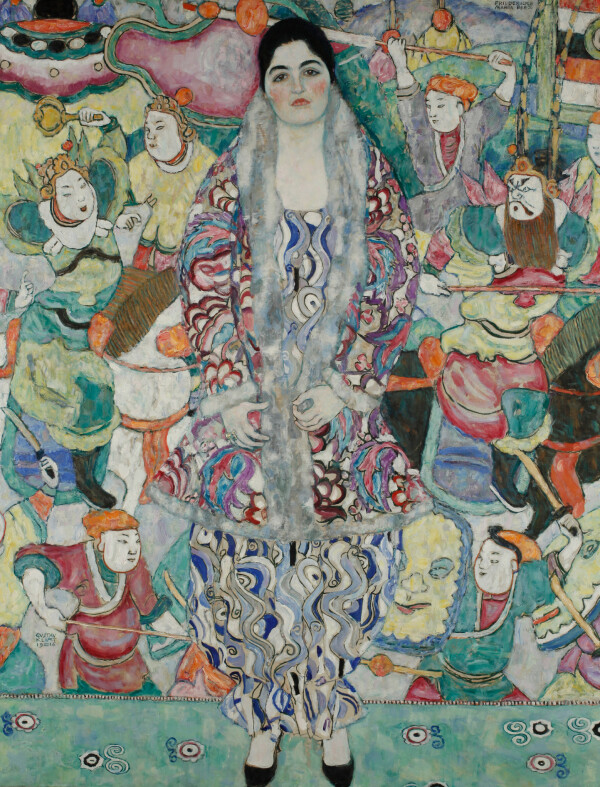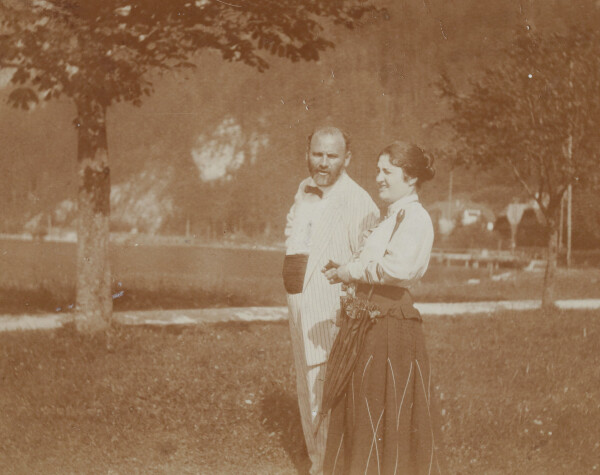Friederike Maria Beer-Monti

Friederike Maria Beer at Lake Attersee, summer 1916, Klimt Foundation
© Klimt Foundation, Vienna

Gustav Klimt: Portrait of Friederike Maria Beer, 1916, Tel Aviv Museum of Art, The Mizne-Blumental Collection
© Tel Aviv Museum of Art

Gustav Klimt and Friederike Maria Beer on a walk in Weissenbach, summer 1916, Klimt Foundation
© Klimt Foundation, Vienna
The life of the cosmopolitan Friederike Maria Beer-Monti was determined by art. Three painters of Vienna’s avant-garde – Hans Böhler, Egon Schiele and Gustav Klimt – created portraits of this glamorous lady, who had a taste for the fashion of the Wiener Werkstätte.
Friederike Maria Beer and Vienna’s Avant-Garde
Friederike Maria Beer was born as the daughter of the Jewish merchant Emil Beer and his wife Isabella (née Geissler) in Vienna on 27 January 1891. Following her father’s premature death, her mother became the owner of the legendary “Kaiserbar,” a “place of rendezvous for the world of theater and art” in Vienna’s 1st District (at Krugerstraße 3).
Ever since her childhood, she was friends with the painter Hans Böhler, who came from a wealthy family of industrialists and patrons of the arts. They also had a long affair. Through Böhler, who was artistically rooted in Vienna’s avant-garde, Friederike became familiar with the art scene of her time. In 1908, Böhler captured the then 17-year-old girl in the work Standing Female Nude (privately owned). This work, which was perceived as scandalous at the time, and their parents’ disapproval of their relationship led to Friederike’s being sent to a Belgian boarding school in 1909. Böhler was sent to China, where his family operated several factories. Both returned to Vienna in 1911. From now on, Beer served as a testimonial for the Wiener Werkstätte – she called herself a “walking advertisement” for this innovative arts and crafts collective. In 1913/14, she went on a tour of Central and South America together with Hans and his brother Richard Böhler. In 1914, at the latest, Beer moved into an apartment at Laimgrubengasse 4 (Vienna-Mariahilf, 6th District), which had been decorated by Josef Hoffmann and the Wiener Werkstätte. In the same year, Egon Schiele captured the young woman, wearing a dress of the Wiener Werkstätte, in oil on canvas. Böhler had introduced them. Schiele’s work Portrait of Friederike Maria Beer (privately owned) was presented in the artist’s solo exhibition at the Arnot Gallery in Vienna the same year.
“What Do You Want from Me?” Meetings with Gustav Klimt
In addition to her portraits by Böhler and Schiele, Beer was also portrayed by Klimt. She recalled later that when she presented herself at his studio at Feldmühlgasse 11 (previously Feldmühlgasse 9, Vienna-Hietzing, 13th District) in November 1915, he said to her: “What do you want from me? You’ve just been painted by Schiele!” After thoroughly inspecting the charismatic lady, however, Klimt finally accepted the commission. As a preparation for the work, he created at least 40 sketches and detailed studies, in which the model is wearing many different outfits, some of them created by the Wiener Werkstätte. In the final Portrait of Friederike Maria Beer (1916, Tel Aviv Museum of Art, The Mizne-Blumenthal Collection), the subject is wearing a dress designed by Eduard Josef Wimmer-Wisgrill and made from the pongee “Marina,” designed by Dagobert Peche. This dress is now part of the collection of the Costume Institute of the Metropolitan Museum of Art, New York. The fur jacket is lined with the colorful fabric “Flora,” designed by Leo Blonder. Klimt insisted that the jacket be turned inside out. Like no other artist, Klimt succeeded in perfectly staging Friederike’s strong character and her relationship to art and fashion.
Beer recalled taking her portrait away from the artist in February 1916 to prevent him from making any further changes. The painting’s price of 20,000 crowns was paid by Böhler, who had initially given Friederike the choice of a pearl necklace or a portrait by Klimt. The work was first presented in 1920 at the “Kunstschau” at the Austrian Museum of Art and Industry (now MAK – Museum of Applied Arts, Vienna).
The painter and his model met again in the summer of 1916. Klimt was spending his last summer sojourn on the Attersee in the forester’s lodge (which still exists today) at the entrance to the Weißenbach Valley. Friederike also spent the summer on the Attersee, together with Hans and Erwin Böhler, who purchased Litzlberg Island that same year. Their meetings with Klimt, Flöge and other summer vacationers are documented in private snapshots.
After Gustav Klimt’s death, Friederike worked at the gallery of Gustav Nebehay from 1918 to 1920, where she arranged and stamped the drawings in Klimt’s estate. In addition to her own portrait, Friederike also owned Gustav Klimt’s painting Kammer Castle on the Attersee II (1909, privately owned), which Böhler had purchased in 1920 and presented to her as a gift.
The Cosmopolitan Friederike Maria Beer-Monti
In the 1920s, Beer left Austria and lived on Procida Island in the Gulf of Naples for a short time. She soon returned to Vienna, however, and lent her portraits created by Klimt and Schiele as well as Kammer Castle on the Attersee II to the Austrian Gallery (now Austrian Gallery Belvedere, Vienna) for the reopening of its “Moderne Abteilung” [“Modern Collection”] in 1929. She moved to New York around 1934 and founded the Artists’ Gallery together with Hugh Sylvan Stix two years later. This gallery became an important point of contact for many artists after 1938, especially for artists who had emigrated from Austria, such as Max Oppenheimer. Friederike held a leading position at the gallery until 1962. In the late 1960s, she sold her works by Böhler, Schiele and Klimt to the Marlborough Fine Art Gallery in London and moved to Hawaii.
Friederike Maria Beer-Monti committed suicide in her 90th year in Kaneohe, Hawaii, on 12 July 1980. She was laid to rest at the Protestant Cemetery in Vienna-Simmering, 11th District.
Literature and sources
- Christian M. Nebehay (Hg.): Gustav Klimt. Dokumentation, Vienna 1969, S. 433-434.
- Alessandra Comini: Egon Schiele’s Portraits, Berkeley - London - Los Angeles 1974, S. 128-132.
- Alice Strobl (Hg.): Gustav Klimt. Die Zeichnungen, Band III, 1912–1918, Salzburg 1984, S. 98-109.
- Martin Suppan: Hans Böhler. Leben und Werke, Vienna 1990.
- Jane Kallir: Egon Schiele. The Complete Works, New York 1990.
- Tobias G. Natter, Gerbert Frodl (Hg.): Klimt und die Frauen, Ausst.-Kat., Upper Belvedere (Vienna), 20.09.2000–07.01.2001, Cologne 2000.
- Tobias G. Natter (Hg.): Gustav Klimt. Sämtliche Gemälde, Vienna 2012.
- Sandra Tretter, Peter Weinhäupl, Felizitas Schreier, Georg Becker (Hg.): Gustav Klimt. Atelier Feldmühlgasse 1911–1918, Vienna 2014, S. 19-22, S. 55.
- Klaus Pumberger: Worüber wir nicht geredet haben. Arisierung, Verdrängung, Widerstand, Ein Haus und die Geschichte zweier Familien, Innsbruck - Bolzano - Vienna 2015.
- Agnes Husslein-Arco, Jane Kallir, Alfred Weidinger (Hg.): Klimt, Schiele, Kokoschka und die Frauen, Ausst.-Kat., Lower Belvedere (Vienna), 22.10.2015–28.02.2016, Munich 2015.
- Sandra Tretter, Peter Weinhäupl (Hg.): Gustav Klimt. Sommerfrische am Attersee 1900-1916, Vienna 2015, S. 76-77, S. 99.
- Egon Schiele online Werkverzeichnis. egonschieleonline.org/works/paintings/work/p276 (03/23/2020).
- Christian Witt-Dörring: Josef Hoffmann’s and Koloman Moser’s Interior Decoration. A Larger Framework for Klimt’s Portraits, in: Tobias G. Natter (Hg.): Klimt and the Women of Vienna's Golden Age. 1900–1918, Ausst.-Kat., New Gallery New York (New York), 22.09.2016–16.01.2017, London - New York 2016, S. 201.
- Carla Carmona Escalera: A comparison of the portraits of Friederike Maria Beer painted by Egon Schiele and Gustav Klimt. Differentiating between scenography and grammar in painting, in: Johann Thomas Ambrózy, Carla Carmona Escalera, Sandra Tretter, Eva Werth (Hg.): Egon Schiele Jahrbuch, Vienna 2019, S. 160-168.

